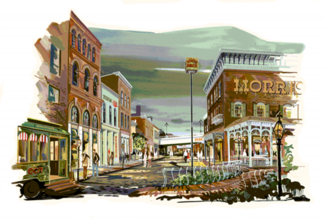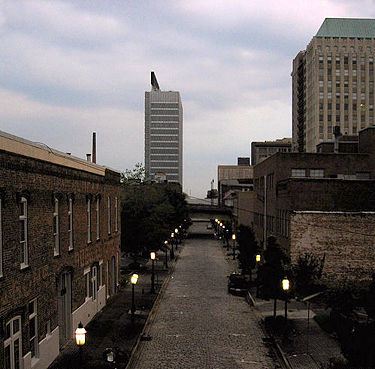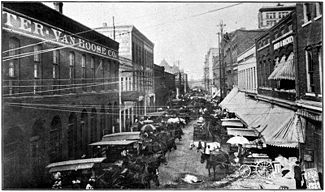Morris Avenue: Difference between revisions
| Line 40: | Line 40: | ||
* 125: former location of [[Broad Street Baptist Church]] (1964) | * 125: former location of [[Broad Street Baptist Church]] (1964) | ||
* 127: former location of [[Robert Marcus residence]] and [[Marcus Beauty Shop]] (1964) | * 127: former location of [[Robert Marcus residence]] and [[Marcus Beauty Shop]] (1964) | ||
* 1400: former location of [[Magic City Hotel]] (1888) | |||
===1600 block=== | ===1600 block=== | ||
Revision as of 15:54, 19 June 2015
Morris Avenue is a narrow, east-west avenue between 1st Avenue North and the Railroad Reservation. Because of its adjacency to railroad depots and services, it rapidly developed into an early commercial and warehouse district in Birmingham's early days. The avenue is named for Josiah Morris, a banker and one of the initial shareholders in the Elyton Land Company who proposed the name "Birmingham" for the new city.
Sections of Morris Avenue can be found between Center Street and 2nd Street North in Elyton, and for a short distance west of 41st Street North and between 42nd and 45th Streets in Avondale. The main section, however, is downtown, between 14th and 25th Streets. Of that section, the area east of 21st Street is the best-preserved late Victorian district in the city.
Downtown section
By the late 1880s Morris Avenue was lined with three and four-story brick warehouses from 21st to 25th Streets.
The Louisville & Nashville Railroad claimed ownership of the section of Morris Avenue between 14th and 18th Streets, which had been used as a produce market and later for automobile parking. In 1969 the railroad blocked off the area to traffic, erecting makeshift barriers and signs saying "No admittance, private property". Leon Aland of the New Ideal department store led legal efforts to keep the street open to public use.
Entertainment district

In the late 1960s, designer Bob Moody became interested in redeveloping Morris Avenue as a historically-themed entertainment and shopping district, similar to Gaslight Square in St Louis, Missouri or the newly-opened Underground Atlanta. With his watercolor sketches and the backing of several other downtown promoters, he interested property owners in the area in the concept. A Gas Lite Club on the 2000 block offered live entertainment in the early 1960s.
Over the next few years the City of Birmingham and the Alabama Legislature contributed support to the venture. It was designated as the state's first historic district and streetscaped with cobblestones and gas lighting. By the Fall of 1972 the first new businesses, such as Diamond Jim's, Oaks Street, Victoria Station, and the Show-Boat Lounge began opening, attracting both locals and tourists at lunchtime and on evenings and weekends.
Old Town Uptown, while popular, proved vulnerable to mismanagement and bad word-of mouth. A few businesses turned over after their initial investments were tapped out. When a visiting businessman was lured from the Show-Boat Lounge and later found dead in August 1977, the district's reputation took a major hit. The sensational crime has been blamed for crippling the viability of the fledgling entertainment district.
A few clubs, like Cobblestone and the Old Town Music Hall continued to draw late-night crowds into the 1980s.
Later development
Over the next decades, the street's historic buildings were renovated, one-by-one, as professional offices and loft residences.
A large parking lot, accentuated with lighting, benches and planting islands, was installed on the south side of the avenue in 1988, supporting the new businesses moving in.
By the 1990s the area was at the center of the first residential loft development downtown and the district has evolved into a tightly-knit mixed use neighborhood. In 1994 jazz club On the Avenue moved from 4th Avenue North to the former Gatsby's location and Larry Levine opened Larry's Place in the train cars that most recently housed Zen.
A new $4.5 million parking deck was built in the late 1990s as the city's contribution to the renovation of the John A. Hand Building for the headquarters of The Bank of Birmingham. A wide pre-cast concrete arch bridges over Morris Avenue on the east side of 20th Street to connect the building to the parking deck. Morris is also bridged by the 21st, 22nd and 24th Street viaducts.
During The Bank's tenure, James A. Taylor placed a vintage red London telephone box at the northeast corner of the intersection. The relic was heavily damaged on April 26, 2006 and subsequently hauled away.
Notable locations
- For an alphabetical list of locations, see the Morris Avenue category.
Center Street to 2nd Street
- 111: former location of William Fairley residence and Fairley Confectionary (1964)
- 125: former location of Broad Street Baptist Church (1964)
- 127: former location of Robert Marcus residence and Marcus Beauty Shop (1964)
- 1400: former location of Magic City Hotel (1888)
1600 block
- Between 16th & 17th Street, former location of Klausman Brewing Company
1700 block
- South side
- 1703: former location of Adams Brothers Produce Co. (1964)
- 1725: former location of Alex Kontos Fruit Co. (1964)
- 1729-1731: former site of Meyer-Marx Co. wholesale wine, liquor and cigars
- 1735: Birmingham Central Station (former location of Banana Warehouse)
1800 block
- North side
- 1820-1822: former site of Gray & Dudley Hardware
- South side
- 1809: S. J. Bennett Professional Building
- 1819: Birmingham Amtrak Station, former location of Louisville & Nashville Railroad offices and passenger station (1964)
- 1821: former location of Louisville & Nashville Railroad passenger traffic (1964)
- 1825: former location of Louisville & Nashville Railroad freight and claims offices (1964)
1900 block
- North side
- 1910: former location of Woodward Billiard Supply Co. (1964)
- 1912: former location of Nichol's Grill (1964)
- 1912½: former location of The Queen Feature Service Inc. (1964)
- 1916½: former location of Armstrong-Smith Co. dental laboratory and Southern Testing Laboratories (1964)
- 1918: former location of Geo. E. Lum Machine & Supply Co., Jessie's Place restaurant (1964)
- South side
- former site of Linn's Park
- 1913: former location of Johnson's Barber Shop (1964)
- 1915: former location of Wayne's Beauty Salon (1964)
- 1917: former location of Zoe's Candies (1964)
- 1919: Two North Twentieth (built 1962 as the Bank for Savings Building), former location of the Relay House hotel (1871-1886), Union Passenger Station/L & N Station (1887-1960)
2000 block
- North side
- 2000: former location of Elyton Land Company building, Hobson Cafe, P & K Cafe, Borders' Hotel
- 2008-2010: former location of First National Bank of Birmingham drive-in teller (1964)
- 2008½: former location of E. L. Higdon Brokerage Co.
- 2012 rear: former location of James A. Head & Co. (1964)
- 2014: McAdory Building (built 1888), Morris Avenue Eye Care, Woolley Law Firm
- 2016: The Peanut Depot (1940s-), former location of the Caldwell Printing Works
- 2018: Arendall & Associates attorneys, formerly C. F. Bell & Company wholesale produce, the Wimberly & Thomas Hardware Co., Mazer's office & store equipment (1964), and a drive-through for MetroBank
- 2024-2026: Re-Print Corporation, formerly a grocery and produce store
- 2030: former location of Dixie Coffee Company
- 2032: former location Birmingham Department of Streets & Sanitation warehouse (1964)
- 2036: former location of Star Provision Company with offices of Dr Byron Dosier upstairs
- South side
- 2001: John A. Hand Building parking deck
- 2017: Douglass Building (built c. 1904 for Douglass Produce Co.), later C. S. Simmons produce company, Diamond Jim's (1974-late 1970s), Kinetic Communications (1995-2013), and the Hogan Law Office.
- 2019-2021: formerly Higdon and McCrary produce company, later Douglass Bros. Produce, Aunt Polly's Kitchen, and part of Diamond Jim's (1974-late 1970s)
- 2021: Lacké Building (built c. 1904), former location of Ridout's Brown-Service funeral parlor, James A. Head & Co. warehouse (1964)
- 2023-2025: Kinetic Communications (built 1885 for the McLester & Van Hoose produce company), later Evansville Packing Company, Birmingham Roofing Co., Victoria Station (1975-1980s), Larry's Place (1994), The Station (1997-2002, 2004-2008), and Zen (2008-2010).
2100 block
- North side
- 2100: former location of C. M. McMahen wholesale grocer
- 2104: former location of Western Union telegraph office
- 2114: former location of J. C. Mayfield Manufacturing Company (1899-1901), Celery-Cola Company (1905-1910), USA Reserve Corps (1964)
- 2120: former location of Spiro's Gaslight Club (1964), Crazy Horse (late 1960s), The Cobblestone (late 1970s)
- 2122: former location of Alabama Home Furniture Co. warehouse (1964)
- 2124-2126: Hendon & Huckestein Architects (built for a printing and grocery business), Town Hall and Fire House bar and cabaret and Old Town Music Hall (1980s)
- 2130: former location of United Foods Inc. wholesale grocer (1964)
- South side
- 2101-2103: former site of Collins & Company wholesale grocers
- 2111: former site of Tyler Grocery Co.
- 2113-2115: former site of Southern Grain & Feed Co., E. C. Adams & Co. (1939)
- 2123: formerly W. M. Cosby mercantile warehouse
- 2125: Najjar Denaburg, P.C., attorneys. Originally the Slaton, McGlathery & Burwell warehouse, later warehouses used by several companies (O. M. Davis Wholesale Grocery Company, Western Grain, Yeilding's Brothers, Hunter's Furniture), redeveloped as Oaks Street, later Charlie's
- 2127: former location of Evansville Packing Co. (1930s)
- 2129-2131: former location of Independent Fish Co. (1964)
2200 block
- North side
- 2202: former location of Robertson Grocery Company wholesale grocers
- 2208: Matthew's Bar & Grill
- 2214: former location of Myers Grocery Co. wholesale grocers (1964)
- 2220-2222: former location of Amaro & Bennett Furniture Co. warehouse (1964)
- South side
- 2201: Adams Design Associates, architects
- 2205: former site of Goodlander Milling Co.
- 2209-2211: former location of H. H. Huffstutler wholesale grocer and J. O. Taylor Grocery Company
- 2213-2215: former location of Wilson & Sons wholesale grocer (1964)
- 2213: Nimrod Long & Associates, landscape architects
- 2223: former location of Cash Produce Co. wholesale grocer (1964)
- 2229: former location of Locasio Salvage Co. warehouse (1964), Freada's Five O'Clock Club
2300 block
- North side
- South side
- 2301-2303: former location of Alabama Mercantile Co. warehouse (1964)
- 2309-2311: former location of Tip Top Freight & Warehouse Co. (1964)
- 2313-2315: former location of Alabama Candy Co.
- 2304: former location of Caroline W's
- 2325: former location of Buckeye Feed & Grain
- 2327: former location of the Morris House restaurant and nightclub (1970s)
2400 block
- North side
- 2430: Carrigan's Public House
- South side
- 2405-2411: former location of Vulcan Furniture Manufacturing Co. (1964)
2500 block
- former location of Adams & Snyder
Avondale
- 4229: former location of Vulcan Roofing & Sheet Metal Co. (1964)
- 4321: former location of CERCO Inc. contractors' rentals (1964)
- 4401: former location of Meadow Steel Products (1964)
- 4415: former location of M & B Metal Products Co. (1964)
Unknown location
- Eclectic Theater (formerly Frontier Lounge, The Cavern, Dr Jekyll's, and The Cavern (Mark II))
- Gas Lite Club
References
- Nix, Charles (March 1970) "L&N, city square off to do battle for historic Morris Ave." Birmingham News - via Birmingham Rewound
- Century Plus: A Bicentennial Portrait of Birmingham Alabama 1976 (1976) Birmingham: Birmingham Chamber of Commerce/Oxmoor Press
- White, Marjorie Longenecker (1977) Downtown Birmingham: Architectural and Historical Walking Tour Guide. Birmingham: Birmingham Historical Society.
- Kennedy, Harold (September 2, 1977) "'Mystery man' suspect hunted in Harlan case." Birmingham News
- Barber, Dean (December 12, 1993) "Night life will return." Birmingham News
- Archibald, John (September 28, 1997) "Morris Avenue reborn: The one-time entertainment district is again teeming with activity, now as offices and residential lofts." Birmingham News.
- Geiss, Chuck (February 24, 2005) "Naked Birmingham". Black & White

